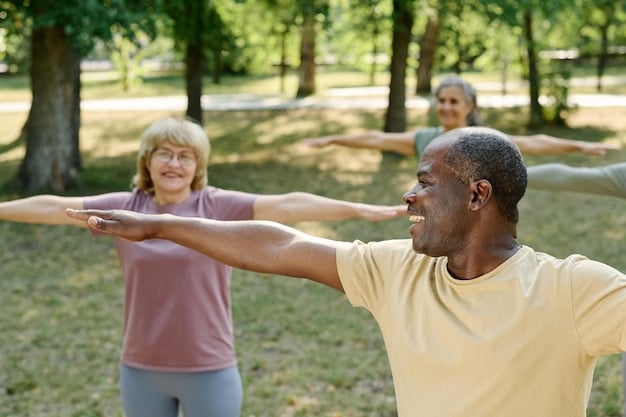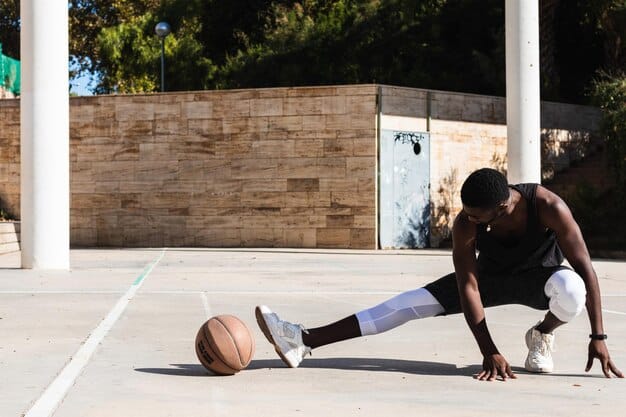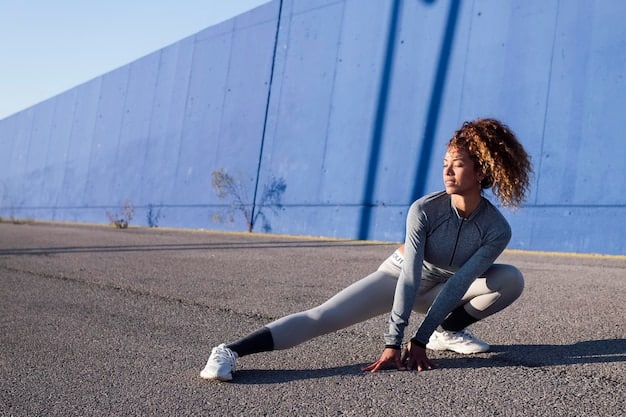Prevent Sports Injuries: Warm-Up & Cool-Down Guide

Preventing sports injuries requires a comprehensive approach, with proper warm-up and cool-down techniques being crucial components to prepare the body for physical activity and promote recovery, ultimately reducing the risk of strains, sprains, and other common injuries.
Want to stay in the game and avoid sidelining injuries? Knowing how to prevent sports injuries: a guide to proper warm-up and cool-down techniques is vital for athletes of all levels, helping to ensure your body is ready to perform and recover effectively.
How to Prevent Sports Injuries: Mastering Warm-Up Techniques
A solid warm-up is the cornerstone of injury prevention. It prepares your body for the demands of your sport, increasing blood flow to muscles and improving flexibility. Let’s dive into the essential aspects of an effective warm-up routine.
The Importance of Dynamic Stretching
Dynamic stretching is a key element. Unlike static stretching, which involves holding a stretch for an extended period, dynamic stretches utilize movement to increase range of motion and prepare muscles for activity.
Think arm circles, leg swings, and torso twists. These movements mimic the actions you’ll perform during your sport, priming your muscles and nervous system.

Sample Dynamic Warm-Up Routine
Here’s a sample routine you can adapt to your specific sport:
- Arm Circles: Small circles forward and backward, gradually increasing in size.
- Leg Swings: Swinging each leg forward and backward, then side to side, controlled movements, focusing on balance and hip mobility.
- Torso Twists: Gently twisting your torso from side to side, keeping your core engaged.
- High Knees: Bringing your knees up towards your chest while jogging in place, engaging the core and hip flexors.
Incorporating these dynamic stretches into your pre-exercise routine can significantly reduce your risk of muscle strains and sprains.
In summary, dynamic stretching is a crucial element of an effective warm-up routine, increasing blood flow, flexibility, and readiness for physical activity. Tailoring your warm-up to the specific demands of your sport will maximize its benefits and contribute to injury prevention.
The Role of Cool-Downs in Injury Prevention
The cool-down is equally important for recovery and preventing injuries. It helps your body gradually return to a resting state, reducing muscle soreness and stiffness. Let’s explore the key components of a proper cool-down.
Static Stretching for Muscle Recovery
Static stretching involves holding a stretch for 30-60 seconds. This helps to lengthen muscles and improve flexibility, reducing post-exercise soreness.
Focus on stretching the muscles you used most during your workout or game. Hold each stretch gently, avoiding bouncing or jerky movements.
Why Cool-Downs Matter
Cool-downs facilitate:
- Reduced Muscle Soreness: Gradual cooling down helps minimize lactic acid build-up, lessening muscle discomfort.
- Improved Flexibility: Gentle static stretches enhance post exercising muscle flexibility.
- Preventing Dizziness: Cooling down gradually stabilizes blood pressure, preventing dizziness.
Don’t skip the cool-down! It’s a vital part of your training routine, helping you recover faster and prevent injuries.

In simple terms, the cool-down process is a vital part of your training regimen, aiding in recovery and preventing injuries by reducing muscle soreness, improving flexibility, and helping your body return to a resting state gradually.
Sport-Specific Warm-Up and Cool-Down Examples
Generic warm-up and cool-down routines are a good starting point, but tailoring them to your specific sport can be even more effective. By focusing on the muscles and movements most commonly used in your sport, you can optimize your injury prevention efforts. Let’s look at some sport-specific examples.
Basketball
Before hitting the court, basketball players need to focus on dynamic stretches like leg swings and torso twists to prepare for running, jumping, and pivoting. Arm circles are also vital for shooting and passing accuracy.
After the game, static stretches targeting the hamstrings, quads, and calves can help reduce muscle soreness. Foam rolling can also be beneficial for releasing tension in these areas.
Swimming
Swimmers should focus on shoulder mobility and flexibility. Arm circles, torso twists, and gentle neck stretches are essential for preparing the upper body for the repetitive movements of swimming.
Cool-down stretches should target the shoulders, lats, and triceps. Holding each stretch for 30 seconds can help reduce muscle tightness and prevent shoulder injuries.
Soccer
Soccer players require flexibility in their lower body and core strength. Dynamic leg swings, high knees, and torso twists are ideal for warming up the muscles used for running, kicking, and tackling.
Static stretches after a match should focus on the hamstrings, quads, groin, and hip flexors. These stretches help prevent muscle strains and improve overall flexibility.
Football
Football warm-ups should include dynamic stretches to prepare for intense bursts of speed and physical contact. Arm circles, torso twists, and leg swings help improve mobility and flexibility.
Post-practice stretches should target major muscle groups like the quads, hamstrings, shoulders, and chest. Foam rolling can also improve muscle flexibility and reduce soreness.
In conclusion, sport-specific warm-up and cool-down routines can significantly enhance injury prevention efforts. Tailoring exercises to the particular movements and demands of your sport ensures that key muscle groups are adequately prepared and efficiently recovered.
The Importance of Proper Hydration and Nutrition
While warm-up and cool-down routines are critical, hydration and nutrition also play a vital role in preventing sports injuries. Dehydration can lead to decreased performance, muscle cramps, and an increased risk of injury. Nutrients are the fuel for your body and the foundation for recovery.
Staying Hydrated
Drink plenty of water before, during, and after exercise. Listen to your body’s thirst cues and aim to stay adequately hydrated throughout the day.
Electrolyte drinks can also be helpful, especially during prolonged or intense workouts, to replenish lost sodium, potassium, and other essential minerals.
Nutrition for Injury Prevention
A balanced diet rich in protein, carbohydrates, and healthy fats is essential for muscle repair and overall health. Consuming adequate protein helps rebuild muscle tissue, while carbohydrates provide energy for workouts.
Here are some nutrition tips:
- Protein: Aim for 0.5-0.8 grams of protein per pound of body weight, distributing intake throughout the day. Choose lean meats, fish, eggs, beans, and lentils for optimal sources.
- Carbohydrates: Prioritize complex carbohydrates, such as whole grains, fruits, and vegetables, for sustained energy release.
- Healthy Fats: Incorporate healthy fats from sources like avocados, nuts, seeds, and olive oil to support hormone production and reduce inflammation.
Proper nutrition is crucial for healing.
In essence, maintaining proper hydration and nutrition is integral to preventing sports injuries, as it supports muscle function, energy levels, and post-exercise recovery. Consuming enough water, electrolytes, protein, and carbohydrates optimizes physical performance and reduces the risk of injury, ensuring a balanced approach to athletic well-being.
Overtraining and the Risk of Injury
Overtraining occurs when you train too hard or too frequently without allowing your body adequate time to recover. This can lead to fatigue, decreased performance, and an increased risk of injuries. Here’s how to recognise overtraining to prevent related injuries.
Recognizing the Signs of Overtraining
Pay attention to your body and be aware of the warning signs of overtraining, which include:
Persistent fatigue, decreased performance, increased soreness, difficulty sleeping, irritability, and loss of appetite are all indicators. If you experience any of these symptoms, it’s essential to reduce your training load and prioritize recovery.
Strategies for Preventing Overtraining
Preventing overtraining entails:
- Adequate Rest: Ensure you get enough sleep each night that is usually between 7-9 hours. Sleep is crucial for muscle recovery and overall health.
- Proper Nutrition: Following a well-balanced diet helps your body repair and rebuild muscle tissue.
- Listening to Your Body: Do not ignore pain or discomfort. Rest or seek medical attention if needed. Consult a physical therapist to help prevent injury.
Overtraining can be subtle!
To summarise, understanding and preventing overtraining is vital for reducing the risk of sports injuries. Recognising symptoms early, prioritising rest and recovery, and incorporating variation into training help athletes avoid physical exhaustion and keep a safe training balance.
The Importance of Proper Gear and Equipment
Using the right gear and equipment is essential for preventing sports injuries. Properly fitted and well-maintained equipment can provide protection, support, and enhance performance. Lets check how selecting appropriate clothing can reduce injury.
Choosing the Right Footwear
Wearing appropriate footwear for your sport is crucial. Shoes should provide adequate support, cushioning, and traction. Replace your shoes regularly, as they can lose cushioning and support over time.
Consider the type of surface you’ll be playing on when selecting footwear. For example, running shoes are designed for pavement or track, while cleats are necessary for playing on grass or turf.
Protective Gear
Depending on your sport, protective gear may be necessary to prevent injuries. This may include helmets, pads, mouthguards, and eye protection.
Ensure that your protective gear fits properly and is in good condition. Replace damaged or worn-out gear to maintain adequate protection.
Clothing Choice
Appropriate athletic clothing can reduce risk of injury.
- Temperature: Dress to the temperature to keep muscles warm and limber.
- Loose fitting: Wear loose fitting material to avoid constriction.
- Sport appropriate: Different sports can change the outcome.
Clothing matters for injury prevention. This is very similar to any sport equipment for safety.
In sum, the use of right equipment is central to the prevention of sports injuries. Footwear suited to the sport, well-maintained protective gear, and athletic clothing will provide support, protection, and comfort which in turn mitigates the risks to physical trauma and ensures better performance.
| Key Point | Brief Description |
|---|---|
| 🏃 Warm-Up | Prepares the body with dynamic stretches, increasing blood flow and flexibility. |
| 🧘 Cool-Down | Aids recovery with static stretches, reducing soreness and improving flexibility. |
| 💧 Hydration & Nutrition | Maintains muscle function and energy with water, electrolytes, protein, and carbs. |
| 😴 Rest & Recovery | Prevents overtraining by ensuring adequate sleep and listening to your body. |
FAQ Section
▼
Warm-ups are crucial because they prepare your muscles for physical activity, increasing blood flow and reducing the risk of strains. They also improve flexibility and range of motion.
▼
Dynamic stretching involves movement to increase range of motion, like leg swings. Static stretching means holding a stretch for an extended period to lengthen muscles, commonly post-workout.
▼
Cooling down is essential for gradually returning your body to a resting state, reducing muscle soreness and stiffness. It also helps to prevent dizziness and improves overall recovery.
▼
Proper hydration is crucial because dehydration can lead to decreased performance, muscle cramps, and an increased risk of injury. Staying hydrated ensures your muscles function properly.
▼
Protective gear, such as helmets and pads, provides essential protection against impact and trauma. Using properly fitted gear significantly reduces the risk of severe injuries during sports activities.
Conclusion
In conclusion, preventing sports injuries: a guide to proper warm-up and cool-down techniques involves a multifaceted approach. By prioritizing effective warm-up and cool-down routines, sport-specific exercises, proper hydration and nutrition, recognizing the signs of overtraining, and using appropriate gear, athletes can significantly reduce their risk of injuries and stay active. Remember, consistency and mindful practice are key to enjoying a long and healthy athletic journey.